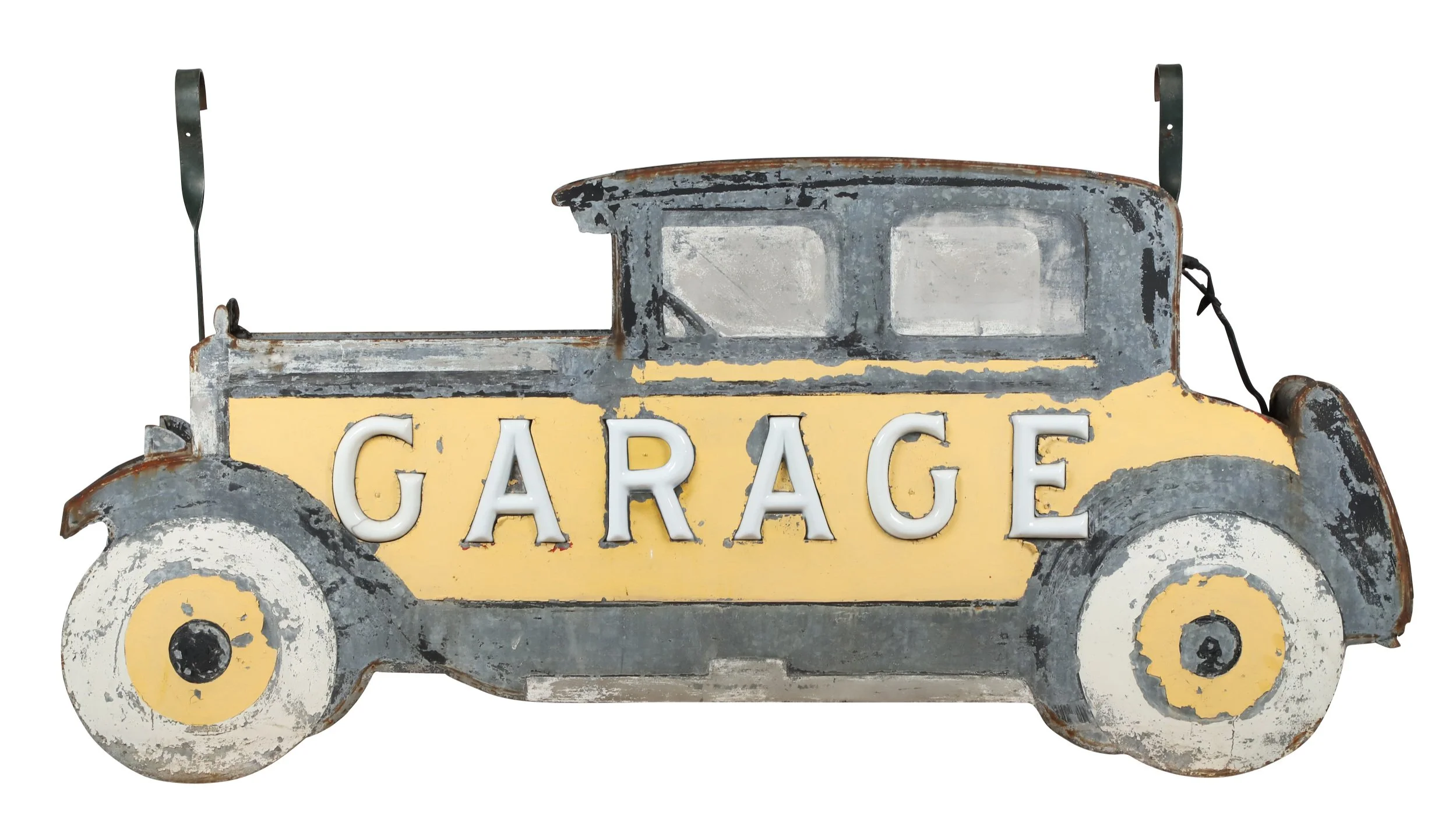A sign of a good business
Rare garage sign: Few made and fewer survived
After a quick stop at the auction block, a striking icon of Canadian automotive history will hit the road on June 15. Nearly a century old, a large handcrafted, three-dimensional trade sign in the shape of an Essex Super Six Coach will be sold in Miller & Miller’s sale of Automobilia, Petroliana and Advertising, featuring the late Dr. Michael Francis Collection.
There’s an old saying that claims “a good sign is a sign of a good business”, but this sign tells us even more. Bearing a striking resemblance to a 1920s Essex Super Six Coach, this monumental garage sign was built for a Ford-Essex Garage in Ancaster, Ontario in the late 1920s. Hand-forged from galvanized sheet metal, it is an outstanding display of early 20th century pride and craftsmanship. It is composed of two identical sides, secured to a core with hundreds of machine screws. The word “GARAGE” is illuminated on both sides by internal light bulbs, strategically placed behind the milk glass (opal) letters. Most remarkably, it features a windshield visor, radiator ornament, headlights, and a rear-mounted spare—all crafted with such detail that suggests the maker stopped just short of giving it actual wheels.
The sign was created in the 1920s for a Ford-Essex Garage in Ancaster, Ontario. It is pictured in the photo above, displayed proudly above the garage entrance.
At first glance, some might suggest it was modeled after a Ford Model A, another popular car of the era. But according to Kevin Nesbitt, historian and board member of the Antique and Classic Car Club of Canada, it looks like an Essex.
"The nose is too long and the headlights are much too low to be a Ford Model A," explains Nesbitt. "However, it is very likely to be an Essex. In fact, I believe it to be a representation of an 'Essex Super Six Coach'."
Pictured above is a 1926 Essex Super Six Coach. Can you spot the similarities?
Nesbitt noted that while the sign may not be an exact replica of any specific vehicle, it is evident where the maker found inspiration.
“Note the lower position of the headlights, the long snout and the leaning spare tire at rear,” adds Nesbitt. “The resemblance to the Essex Super Six Coach is striking.”
Not long before the creation of this sign, most cars on the market were “open” models—meaning they lacked permanent roofs and doors with windows. Open cars exposed passengers to the elements, noise, and dirt, yet they were far cheaper than their “luxurious” enclosed counterparts. In 1922, Essex revolutionized the market with the introduction of the Essex Coach. It was the first enclosed car that was affordable for the masses. Consumers could now enjoy the “year-round comfort” and protection of an enclosed vehicle, for nearly the same price as an “open” car.
In the early 1920s, Essex revolutionized the market with the introduction of the enclosed Essex Coach. Source.
While proving the make and model of the depicted vehicle adds historical interest to the sign, it's the “Garage” subject, the age, and the way it was made that deems this a serious sign. Illuminated trade signs are among the most prized treasures in North American advertising collecting. They were large and fragile; few were made, and fewer survived. Fortunately, this one hung high and dry above the commotion of the Ford-Essex Garage it was made for. This sign remains in its original, as-found state with the exception of an “in service overpaint” early in its life. One milk glass “R” (shown missing in the photo below) was professionally replicated using the remaining "R" as a template.
Pictured above is the sign when it had one missing “R”, which was later professionally replicated.
The “R” after restoration.
Offered as lot 220 in the sale, the sign is expected to fetch between CA$20,000 and CA$30,000. It hits on all levels. For collectors of automobilia and advertising, it is a visual capstone to any collection. For others, juxtaposed to recent automotive innovations that include the sleek lines of Tesla, it is a reminder of where a century has taken us. Buckle up! This enclosed ride is one you don’t want to miss.
Story by Tess Malloy
Tess is a freelance writer and history enthusiast who enjoys unearthing interesting stories about remarkable people and objects. Tess has written for The Miller Times for six years.
SALE DETAILS:
Automobilia, Petroliana & Advertising
Featuring the Late Dr. Michael Francis Collection
June 15, 2024 | 9am EST







